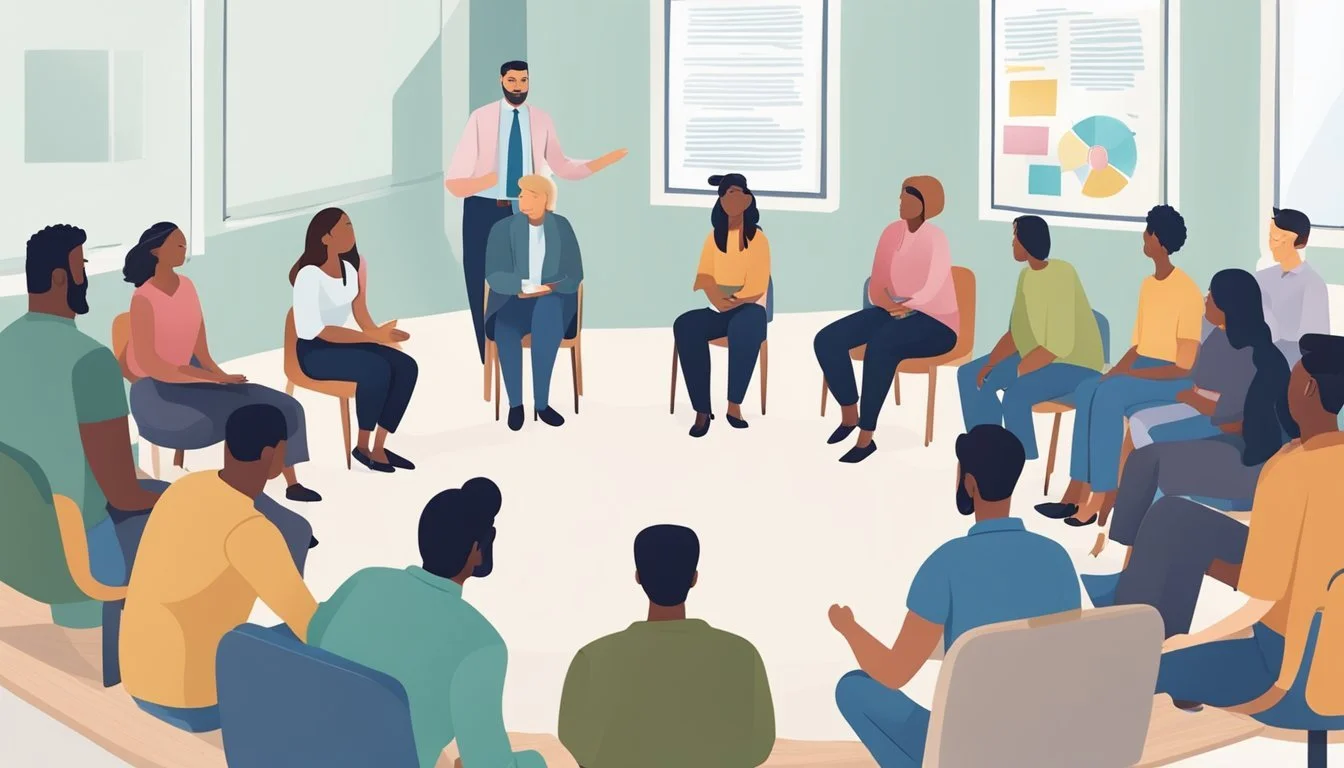12 Strategies for Managing PTSD Symptoms in Leadership Roles
Practical Solutions for Effective Leadership
Managing PTSD symptoms can be particularly challenging for those in leadership roles due to the additional stressors and responsibilities they face. Leaders are often viewed as pillars of strength, making it crucial to address the impact of PTSD on their ability to guide and support their teams effectively.
Empowering leaders with strategies to manage PTSD symptoms can significantly enhance their resilience and effectiveness. By implementing practical approaches, leaders not only improve their own well-being but also create a more supportive and understanding workplace environment for everyone. This article aims to explore various methods that can help leaders maintain their mental health while fulfilling their key roles.
1) Seek Therapy
Seeking therapy is a fundamental step for those in leadership roles dealing with PTSD symptoms. Professional help can provide structured and effective treatment plans tailored to individual needs.
Therapists trained in PTSD can offer cognitive-behavioral therapy (CBT), which is proven to reduce PTSD symptoms. This form of therapy helps individuals reframe negative thought patterns and develop coping strategies.
Another beneficial approach is Eye Movement Desensitization and Reprocessing (EMDR). EMDR helps in processing traumatic memories and reducing their impact. It involves guided eye movements or other bilateral stimulation techniques.
In some cases, medication may be prescribed to manage symptoms. Antidepressants and antianxiety medications can help alleviate the emotional intensity of PTSD, making it easier to participate in therapy.
Therapy sessions can also provide a safe space to express feelings and experiences. This can lead to better self-understanding and emotional release, which is crucial for healing.
It's important to find a therapist who specializes in trauma and PTSD. This ensures that they are knowledgeable about the condition and the most effective treatment techniques.
Engaging in therapy is a proactive step towards recovery and can significantly improve personal well-being and professional performance. Leaders who address their mental health are better equipped to support their teams and make sound decisions.
2) Practice Mindfulness
Incorporating mindfulness practices into daily routines can significantly help leaders manage PTSD symptoms. Mindfulness can improve focus, reduce stress, and enhance emotional regulation.
Leaders can start by dedicating a few minutes each day to mindful meditation. Just five to ten minutes of controlled breathing and focus on the present moment can make a difference.
Regular practice can help leaders stay calm under pressure. This can be particularly beneficial in high-stress environments, enabling better decision-making and emotional control.
Mindfulness techniques, such as body scanning and mindful observation, can also help leaders develop greater self-awareness. This self-awareness is crucial for recognizing stress triggers and managing reactions effectively.
Using mindfulness to develop empathy is another key benefit. Mindful leaders are better equipped to understand the perspectives and needs of their teams.
Encouraging mindfulness among team members can create a more supportive and cohesive work environment. This can further reduce stress and promote a culture of well-being.
Consistent mindfulness practice can lead to long-term improvements in mental health. Studies have shown that mindfulness training can reduce PTSD symptoms in various populations. For more detailed insights, consider looking into mindfulness training for PTSD.
Adopting mindfulness practices is a practical and effective strategy for leaders facing the challenges of PTSD.
3) Maintain a Support Network
Building and maintaining a strong support network is essential for leaders managing PTSD symptoms. Connecting with supportive colleagues, friends, and family can provide emotional stability and practical assistance. These connections help reduce feelings of isolation that often accompany PTSD.
Leaders should actively seek out and nurture these relationships. Regular check-ins with trusted individuals can create a foundation of trust and understanding. This network can offer perspectives and support in times of need.
Joining a support group specifically for PTSD can be beneficial. These groups provide a safe space to share experiences and coping strategies with others who understand. Online forums and local community resources can be good places to start.
Mentorship is another valuable aspect of a support network. Experienced mentors can offer guidance and advice tailored to leadership roles. This can be particularly helpful for navigating workplace challenges while managing PTSD.
Encouraging team members to develop their own support networks is also important. A supportive work environment where open communication is valued can make a significant difference. Leaders should model this behavior to cultivate a culture of mutual support.
A well-maintained support network is a crucial tool in managing PTSD symptoms and sustaining leadership capabilities. It provides emotional and practical resources that can make a measurable difference in daily functioning.
4) Set Professional Boundaries
Setting professional boundaries is essential for leaders managing PTSD symptoms. Boundaries help create a clear separation between work and personal life, reducing stress.
Leaders should communicate their availability clearly. Specify office hours and response times for emails and calls. This ensures uninterrupted personal time, aiding recovery.
Leaders must also respect their own limits. Avoid overcommitting to tasks and delegate when necessary. This helps prevent burnout and maintain focus on essential responsibilities.
Consistent enforcement of boundaries is crucial. If a boundary is crossed, address it immediately. This reinforces its importance and sets a standard for others.
Educate team members about these boundaries. Clear communication fosters understanding and respect within the team, promoting a healthy work environment.
Utilizing these strategies helps leaders with PTSD maintain control over their work life and better manage symptoms. For more insights on professional boundaries, visit this comprehensive guide.
Implementing these practices can significantly benefit leaders, allowing them to perform effectively while managing their condition.
5) Practice Self-Care
Leaders facing PTSD must prioritize self-care to maintain their well-being. Regular physical activity, such as yoga, can help reduce stress and promote relaxation. Yoga's focus on breathwork and mindfulness can help individuals reconnect with their bodies and release tension.
Engaging in hobbies or activities that bring joy can also aid in managing PTSD symptoms. Whether it's painting, hiking, or reading, finding time for enjoyable activities can provide a healthy escape from daily stressors.
Maintaining a balanced diet and getting adequate sleep are crucial self-care practices. Eating nutritious meals helps support brain function and energy levels. Establishing a regular sleep routine can improve sleep quality and overall health.
Peer support plays a significant role in self-care. Leaders can benefit from connecting with others who understand their experiences. Groups for individuals in high-risk occupations, such as law enforcement, offer peer support using models like the Stress First Aid Model.
Using tools like the PTS Coach Online app, which offers self-assessments and coping skills, can help leaders monitor and manage stress levels effectively.
By integrating these self-care strategies, leaders can better navigate the challenges of PTSD while fulfilling their roles effectively.
6) Develop a Routine
Creating a structured daily routine can be beneficial for individuals with PTSD. Consistency helps in reducing feelings of unpredictability and anxiety. A predictable schedule allows for better time management and reduces stress.
Incorporate regular breaks throughout the day to prevent burnout. Time for activities such as exercise, meals, and rest should be planned in advance.
A routine should include both work-related and personal activities. Balancing these aspects can improve overall well-being. Staying organized with tools like planners or digital calendars can make adherence easier.
Morning routines set the tone for the day. Practices such as mindfulness or meditation can help in starting the day calmly.
Evening routines are crucial for winding down. Establishing a relaxing bedtime routine can enhance sleep quality. This may involve reading or engaging in calming activities.
Flexibility in routines is also important. While consistency is key, it’s essential to adapt the schedule when necessary to accommodate unexpected events.
By developing a structured routine, leaders with PTSD can maintain stability and reduce stress, positively impacting their leadership roles and overall mental health. For more strategies on managing PTSD, refer to Healthy Office Habits.
7) Exercise Regularly
Regular exercise has proven benefits for managing PTSD symptoms.
Engaging in aerobic activities like walking, running, and cycling can improve mood and reduce anxiety. These activities enhance cardiorespiratory fitness, which has been linked to better mental health outcomes in individuals with PTSD.
Strength training, including resistance exercises, is also beneficial. It helps in building physical resilience and supports the management of stress levels.
Mind-body exercises like yoga provide a dual benefit. They not only improve physical health but also support emotional regulation and mindfulness. This can be particularly effective for those dealing with PTSD.
Research indicates that moderate-intensity exercise yields significant mental health benefits. Short bouts of exercise can still be effective, making it easier for individuals with busy schedules to incorporate physical activity into their routine.
For individuals in leadership roles, incorporating regular exercise is essential. It boosts overall well-being, enhances mood, and supports better stress management. This can lead to improved decision-making and leadership effectiveness.
To maintain a consistent exercise routine, it's helpful to set realistic goals and choose activities that are enjoyable. This ensures the exercise regimen is sustainable and offers continual benefits.
Committing to regular exercise can be a powerful strategy in managing PTSD symptoms, especially for those in demanding leadership roles.
8) Use Grounding Techniques
Grounding techniques can be an effective tool for managing PTSD symptoms in leadership roles. These methods help individuals focus on the present moment, reducing feelings of anxiety and panic.
Simple exercises like the 5-4-3-2-1 technique involve engaging the senses to stay connected to reality. It begins with identifying five things seen, four things touched, three things heard, two things smelled, and one thing tasted.
Another method involves deep breathing. Leaders can practice controlled breathing to restore calm and reduce stress. This technique can be easily integrated into daily routines, reducing the impact of sudden flashbacks or panic attacks.
Physical grounding techniques include walking or stretching. Integrating these activities into day-to-day leadership tasks can promote a sense of stability and focus.
Leaders should also consider incorporating grounding objects like stress balls or fidget items. These tools provide tactile feedback that can assist in staying present during stressful moments.
By implementing these strategies, leaders can better manage PTSD symptoms and maintain their effectiveness in demanding roles. Grounding techniques offer practical, immediate relief and are versatile enough to use in various settings.
9) Prioritize Sleep
Ensuring adequate sleep is essential for managing PTSD symptoms effectively. Leaders with PTSD may experience sleep disturbances, which can exacerbate other symptoms and impair their decision-making abilities.
Quality sleep improves cognitive function, emotional regulation, and overall mental health. Addressing sleep issues can reduce daytime fatigue and enhance focus, which is crucial for leadership roles.
There are several approaches to improve sleep in those with PTSD. Cognitive-behavioral therapy for insomnia (CBT-I) has shown positive effects. This therapeutic approach addresses the thoughts and behaviors that contribute to sleep issues.
Pharmacologic treatments can also be helpful. Medications like prazosin have been used to reduce nightmares, a common symptom of PTSD. It's important to consult a healthcare provider to determine the best treatment.
Incorporating healthy sleep habits, such as maintaining a consistent sleep schedule and creating a restful environment, can also make a significant difference. Limiting caffeine and screen time before bed can further improve sleep quality.
Focusing on sleep management not only alleviates PTSD symptoms but also enhances overall well-being and leadership effectiveness. By prioritizing sleep, leaders can better support their teams and fulfill their responsibilities.
10) Educate Your Team
Educating your team about PTSD creates a compassionate and supportive work environment. It helps staff understand what their colleagues might be experiencing and promotes empathy.
Arrange training sessions or workshops to inform team members about PTSD's effects and symptoms. This can be facilitated by mental health professionals who specialize in PTSD.
Provide accessible resources such as articles, videos, or pamphlets that explain PTSD. These materials can offer practical advice on how to support colleagues with PTSD.
Encourage open communication where employees feel safe discussing mental health. A culture of transparency can reduce stigma and foster a sense of inclusivity.
Consider ongoing education to keep knowledge up-to-date. Regular updates ensure the team remains informed about best practices for supporting those with PTSD.
For more detailed guidance, visiting Mind Tools can be beneficial. Another useful resource is Healthy Office Habits, which offers practical tips for employers.
Educational initiatives can significantly impact the well-being of employees with PTSD and contribute to a healthier workplace.
11) Delegate Tasks
Delegating tasks is crucial for leaders managing PTSD symptoms. It reduces the burden on a single person, allowing them to focus on critical responsibilities. By spreading out tasks, leaders can avoid feeling overwhelmed and maintain productivity.
Effective delegation involves clear communication. Leaders should provide precise instructions and ensure team members understand their roles. This clarity helps prevent misunderstandings and keeps projects on track.
Leaders need to trust their team. Building trust fosters a supportive environment where team members feel valued and responsible. This trust also allows leaders to step back when necessary, giving themselves time to manage their symptoms effectively.
Acknowledging team efforts is essential. Recognizing and celebrating achievements boosts morale and encourages continued dedication. High morale within the team can reduce the pressure on leaders and contribute positively to their mental health.
Lastly, leaders should be open to feedback about their delegation methods. Continuous improvement in delegating can lead to better outcomes for both the leader and the team. Listening to feedback demonstrates a commitment to effective teamwork and personal growth.
For more practical tips on how leaders can delegate successfully, consider exploring Harvard Business Review's guide on delegating.
12) Access Support Groups
Engaging with support groups can be an invaluable strategy for managing PTSD symptoms. These groups provide a space to connect with others who share similar experiences. This sense of community can alleviate feelings of isolation.
Support groups offer a platform to share coping strategies and receive encouragement. Participating in these groups can enhance emotional well-being, even if they don't directly reduce PTSD symptoms.
Leaders with PTSD may find peer support groups especially beneficial. The exchange of stories and advice can lead to new insights and coping mechanisms. This interaction fosters a supportive environment.
Many organizations offer peer support groups, both in-person and online. Examples include the National Center for PTSD and various mental health nonprofits.
It's important to find a group that fits one’s specific needs. Some groups cater to particular demographics or trauma types. Exploring different options can help ensure the most beneficial experience.
Accessing support groups requires commitment and openness. Regular attendance and active participation can maximize the benefits. Engaging regularly helps build stronger connections within the group.
Joining a support group is not a substitute for professional therapy. However, it serves as a complementary resource. Leaders can combine the emotional support from peers with clinical guidance.
Such groups play a crucial role in creating a balanced approach to PTSD management. By regularly accessing support groups, leaders can better navigate their mental health challenges.
Understanding PTSD in Leadership Roles
Post-traumatic stress disorder (PTSD) can significantly affect individuals in leadership roles, influencing their decision-making, interactions, and overall performance. This section covers the key aspects of PTSD, its impact on leadership, and the specific challenges leaders with PTSD might encounter.
Definition and Symptoms of PTSD
PTSD is a mental health condition triggered by experiencing or witnessing a traumatic event. Symptoms include flashbacks, nightmares, severe anxiety, and uncontrollable thoughts about the event. These symptoms can manifest differently in individuals, often leading to irritability, insomnia, and difficulty concentrating.
Leaders with PTSD might struggle with heightened stress, making it hard to maintain focus. Anxiety and hypervigilance can interfere with their ability to manage daily tasks and responsibilities effectively. Recognizing these symptoms is crucial for implementing appropriate support and strategies.
Impact of PTSD on Leadership
PTSD can notably impair leadership abilities. Leaders may find it challenging to remain composed under pressure, potentially leading to impulsive decisions or avoidance of critical issues. Emotional regulation becomes difficult, which can affect team dynamics and morale.
Leaders with PTSD might also exhibit less engagement and reduced productivity. Their ability to inspire and motivate their team can be compromised. Consequently, this can create an environment of uncertainty and insecurity among team members, affecting overall performance and cohesion.
Challenges Faced by Leaders with PTSD
One primary challenge is maintaining consistency. Leaders with PTSD may experience fluctuating energy levels, making it tough to keep a steady pace. They might also face stigma, which can discourage them from seeking help, fearing that it will impact their professional reputation.
Another significant challenge is managing triggers within the workplace. Stressful situations or conflict can exacerbate PTSD symptoms, leading to periods of dysfunction. This can result in a loss of confidence both in themselves and from their team. Developing coping mechanisms and fostering a supportive environment are essential for leaders to handle these challenges effectively.
Balancing their responsibilities while managing PTSD requires both personal and professional support systems.
Effective Communication Strategies
Effective communication is paramount when managing PTSD symptoms in leadership roles. Key strategies focus on building trust within teams and promoting open dialogue to ensure a supportive and understanding environment.
Building Trust within Teams
Trust forms the foundation of any effective team. Leaders should practice transparency by sharing relevant information promptly and honestly. This approach helps create a dependable and trustworthy atmosphere.
Regular team meetings can foster a sense of community and reliability. During these sessions, leaders should encourage participation and listen actively. It's crucial to show empathy and understanding, especially when team members share personal experiences or challenges related to PTSD.
Leaders should also follow through on commitments. Consistency in actions and decisions reinforces trust and reliability within the team. Recognizing and acknowledging individual and collective achievements can further strengthen trust and encourage a supportive culture.
Promoting Open Dialogue
Open dialogue encourages team members to express their thoughts and feelings without fear of judgment. Leaders should create safe spaces where individuals feel comfortable discussing their experiences with PTSD.
Active listening is a critical component of open dialogue. Leaders should demonstrate they are attentive by summarizing key points and asking follow-up questions. This practice shows respect and genuine interest, which can significantly enhance communication.
Confidentiality should be maintained to promote openness. When team members know that their disclosures will be respected and kept private, they are more likely to share openly. This approach can lead to deeper understanding and better support for those managing PTSD symptoms.











